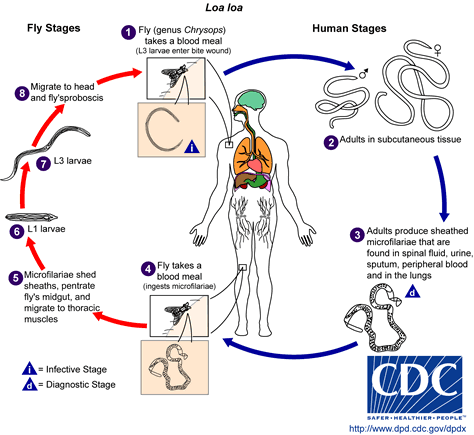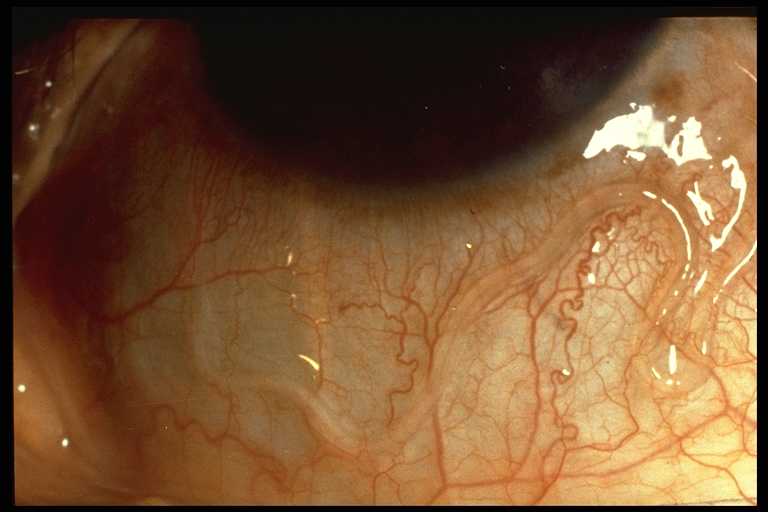Introduction to Diagnostic Medical Parasitology
Essentials
Loa loa is a filarial nematode, which is also known as the West African eye worm. The infection is chronic and is either asymptomatic or with skin manifestations (transient pruritus, oedema).

Loa loa is transmitted by African tabanid flies which live in the rain forest. The distribution of the disease is related to the distribution of the vector. Infective larvae leave the insect during a blood meal and develop subcutaneously to adult worms (3-7 cm long). These worms can be observed crossing the eye under the conjunctiva. About 1 year later, female worms start producing microfilariae (about 250 µm in length), which are found periodically (peak at noon) in the peripheral day blood. Immunity to microfilariae results in - occult loiasis - with no detectable microfilariae. Microfilariae are taken up by the vector with a blood meal. They penetrate the gut wall and develop in the fat body to third-stage larvae within 2 weeks.

Epidemiology
- Widely distributed in the African rain forest, especially in Central Africa
- Besides humans, monkeys can also be infected
- Transmission by day-biting tabanid flies
Pathology
- Migration of immature and adult worms in subcutaneous tissue is very often asymptomatic
- In sensitized patients, hyper-reactions against excretory/secretory products and microfilariae may lead to oedemas (calabar swellings)
- Live adult worms do not evoke inflammatory reactions in contrast to dying worms which elicit granulomatous reactions and fibrosis
- High blood eosinophilia is common
Clinical Findings
- Recurring skin lesions at different body sites with pruritus and urticaria followed by oedema (calabar swelling) are transient (for 2–3 days)
- Migration of the adult worm across the conjunctiva may result in irritation, pain and congestion of the conjunctiva but is also often without symptoms


Diagnosis
Diagnostic method
Parasitological diagnosis
Microfilariae can be found in day blood (peak between noon and 2 p.m.). However, many infected individuals are amicrofilaraemic due to immunity to microfilariae (“occult loiasis”). Standard procedure: membrane filtration or lysis of blood (Knott’s method).
Adult worms may be seen migrating through the conjunctiva. Fugitive swellings (calabar oedema) are characteristic for loiasis.
Molecular diagnosis
PCR methods detecting two repetitive DNA sequences of Loa loa in whole blood have been described but are not yet standardized.
Antigen detection
Attempts to develop a sensitive antigen detection assay have been unsuccessful so far.
Antibody detection
Serological tests detect circulating antibodies in loiasis lack specificity (cross-reacting antibodies from Mansonella perstans and other filarial infections) and are unable to distinguish between past and current infection.
Diagnostic strategies for various diagnostic goals rely on clinical findings and the demonstration of microfilariae.

Prevention and control
- To avoid insect bites in endemic areas by repellents and adequate clothing